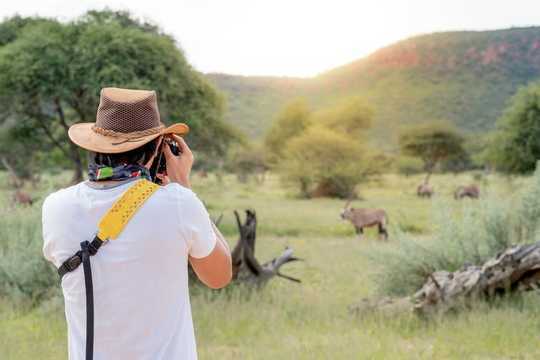Animal populations have declined on average by 60% since 1970, and it’s predicted that around a million species are at risk of extinction. As more of the Earth’s biodiversity disappears and the human population grows, protected landscapes that are set aside to conserve biodiversity are increasingly important. Sadly, many are underfunded – some of Africa’s most treasured wildlife reserves operate in funding deficits of hundreds of millions of dollars.
In unfenced wilderness, scientists rarely have an inventory on the exact numbers of species in an area at a particular time. Instead they make inferences using one of many different survey approaches, including camera traps, track surveys, and drones. These methods can estimate how much and what kind of wildlife is present, but often require large amounts of effort, time and money.
Camera traps are placed in remote locations and activated by movement. They can collect vast quantities of data by taking photographs and videos of passing animals. But this can cost tens of thousands of dollars to run and once in the wild, cameras are at the mercy of curious wildlife.
Track surveys rely on specialist trackers, who aren’t always available and drones, while promising, have restricted access to many tourism areas in Africa. All of this makes wildlife monitoring difficult to carry out and repeat over large areas. Without knowing what’s out there, making conservation decisions based on evidence becomes almost impossible.
Citizen Science on Safari
Tourism is one of the fastest growing industries in the world – 42m people visited sub-Saharan Africa in 2018 alone. Many come for the unique wildlife and unknowingly collect valuable conservation data with their phones and cameras. Photographs on social media are already being used to help track the illegal wildlife trade and how often areas of wilderness are visited by tourists.
Despite this, tourists and their guides are still an overlooked source of information. Could your holidays snaps help monitor endangered wildlife? In a recent study, we tested exactly this.
Partnering with a tour operator in Botswana, we approached all guests passing through a safari lodge over three months in the Okavango Delta and asked them if they were interested in contributing their photographs to help with conservation. We provided those interested with a small GPS logger – the type commonly used for tracking pet cats – so that we could see where the images were being taken.
We then collected, processed, and passed the images through computer models to estimate the densities of five large African carnivore species – lions, spotted hyaenas, leopards, African wild dogs and cheetahs. We compared these densities to those from three of the most popular carnivore survey approaches in Africa – camera trapping, track surveys, and call-in stations, which play sounds through a loudspeaker to attract wildlife so they can be counted.
The tourist photographs provided similar estimates to the other approaches and were, in total, cheaper to collect and process. Relying on tourists to help survey wildlife saved up to US$840 per survey season. Even better, it was the only method to detect cheetahs in the area – though so few were sighted that their total density couldn’t be confirmed.
Thousands of wildlife photographs are taken every day, and the study showed that we can use statistical models to cut through the noise and get valuable data for conservation. Still, relying on researchers to visit tourist groups and coordinate their photograph collection would be difficult to replicate across many areas. Luckily, that’s where wildlife tour operators could come in.
Tour operators could help collect tourist images to share with researchers. If the efforts of tourists were paired with AI that could process millions of images quickly, conservationists could have a simple and low-cost method for monitoring wildlife.
Tourist photographs are best suited for monitoring large species that live in areas often visited by tourists – species that tend to have high economic and ecological value. While this method perhaps isn’t as well suited to smaller species, it can still indirectly support their conservation by helping protect the landscapes they live in.
The line between true wilderness and landscapes modified by humans is becoming increasingly blurred, and more people are visiting wildlife in their natural habitats. This isn’t always a good thing, but maybe conservationists can use these travels to their advantage and help conserve some of the most iconic species on our planet.![]()
About The Author
Kasim Rafiq, Postdoctoral Researcher in Wildlife Ecology and Conservation, Liverpool John Moores University
This article is republished from The Conversation under a Creative Commons license. Read the original article.
Books on The Environment from Amazon's Best Sellers list
"Silent Spring"
by Rachel Carson
This classic book is a landmark in the history of environmentalism, drawing attention to the harmful effects of pesticides and their impact on the natural world. Carson's work helped to inspire the modern environmental movement and remains relevant today, as we continue to grapple with the challenges of environmental health.
Click for more info or to order
"The Uninhabitable Earth: Life After Warming"
by David Wallace-Wells
In this book, David Wallace-Wells offers a stark warning about the devastating effects of climate change and the urgent need to address this global crisis. The book draws on scientific research and real-world examples to provide a sobering look at the future we face if we fail to take action.
Click for more info or to order
"The Hidden Life of Trees: What They Feel, How They Communicate?Discoveries from A Secret World"
by Peter Wohlleben
In this book, Peter Wohlleben explores the fascinating world of trees and their role in the ecosystem. The book draws on scientific research and Wohlleben's own experiences as a forester to offer insights into the complex ways that trees interact with one another and the natural world.
Click for more info or to order
"Our House Is on Fire: Scenes of a Family and a Planet in Crisis"
by Greta Thunberg, Svante Thunberg, and Malena Ernman
In this book, climate activist Greta Thunberg and her family offer a personal account of their journey to raise awareness about the urgent need to address climate change. The book provides a powerful and moving account of the challenges we face and the need for action.
Click for more info or to order
"The Sixth Extinction: An Unnatural History"
by Elizabeth Kolbert
In this book, Elizabeth Kolbert explores the ongoing mass extinction of species caused by human activity, drawing on scientific research and real-world examples to provide a sobering look at the impact of human activity on the natural world. The book offers a compelling call to action to protect the diversity of life on Earth.


























